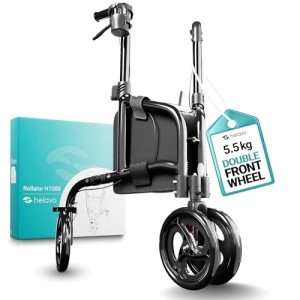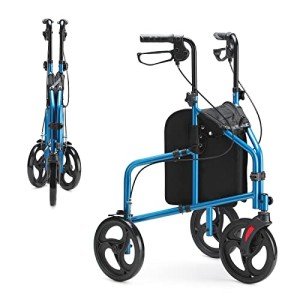
16
MayThe Main Issue With Rollator Walker And What You Can Do To Fix It

Rollator Walker Safety: A Comprehensive Guide
As people age or face mobility challenges due to illness or injury, keeping self-reliance often ends up being a concern. Rollator For Elderly walkers, providing both assistance and mobility, have actually ended up being important tools for numerous. However, while they provide many benefits, ensuring safety while using a rollator walker is critical. This short article provides comprehensive insights into rollator OasisSpace 3-Wheel Foldable Walker - Easy Mobility safety, consisting of best practices, common dangers, and essential suggestions for users and caretakers.
Comprehending Rollators
A Rollator For Hiking walker is a mobility device with wheels that enables people to stroll with the assistance of a frame. Unlike standard walkers, rollators usually feature:
- Three or four wheels for simpler maneuverability
- Hand brakes for stopping and controlling speed
- A seat for resting when required
- Storage compartments for bring personal products
These features make rollators suitable for both indoor and outdoor use, improving the lifestyle for users by offering a sense of independence.
Benefits of Using Rollator Walkers
- Increased Mobility: Rollators can help users in walking around safely and easily.
- Assistance and Stability: With a sturdy frame and brakes, they supply necessary assistance when standing or walking.
- Convenience: Many rollators featured cushioned seats, enabling users to rest as needed.
- Convenience: Integrated storage options can bring vital products, freeing hands for better balance.
Common Hazards Associated with Rollator Walkers
While rollators can improve mobility and safety, they can likewise posture threats. Users need to understand prospective dangers to reduce accidents:
- Uneven Surfaces: Rollators may topple if utilized on irregular or sloped terrain.
- Braking Issues: Failing to engage the brakes effectively can cause falls.
- Excess Weight: Overloading the storage compartments can impact stability.
- Incorrect Use: Not using the rollator as meant can lead to accidents.
- Poor Maintenance: Neglecting regular checks on wheels and brakes could cause failure throughout use.
Rollator Walker Safety Tips
To enhance safety while utilizing rollator walkers, consider the following suggestions:
1. Appropriate Fit and Adjustment
- Height Adjustment: Ensure that the handle height is set to the user's wrist level when standing upright. An appropriate fit encourages much better posture and control.
- Seat Height: If the rollator has a seat, ensure it's comfortable and accessible for resting.
2. Routine Maintenance
- Inspect Brakes: Make sure hand brakes are working properly. Adjust or replace them if necessary.
- Check Wheels: Regularly inspect wheels for wear and tear, and guarantee they spin freely.
- Analyze Frame: Check for loose screws or fractures in the frame to ensure it stays sturdy.
| Maintenance Task | Frequency |
|---|---|
| Brake check | Weekly |
| Wheel inspection | Month-to-month |
| Frame examination | Regular monthly |
3. Environment Awareness
- Clear Pathways: Keep living areas devoid of mess and challenges that may pose a tripping risk.
- Lighting: Ensure that areas are well-lit to prevent mistakes, especially during evening hours.
- Avoid Slippery Floors: Be mindful on wet or waxed floors, as they can lead to falls.
4. Safe Walking Techniques
- Engage Brakes When Stopping: Always engage brakes before sitting or while resting.
- Use Proper Walking Technique: Move slowly and preserve a stable rate, taking steps that match the rollator's width.
- Balance While Turning: Turn thoroughly, utilizing the rollator for support as needed.
5. Look for Assistance
- Include Caregivers: Encourage household members or caregivers to assist in browsing challenging terrains or circumstances.
- Make The Most Of Community Resources: Many neighborhoods use Mobility Aid training for those utilizing walk-assisting gadgets.
Frequently Asked Questions about Rollator Walker Safety
Q1: How do I choose the right rollator walker?
When choosing a rollator, think about the user's weight, height, and planned use. It's likewise necessary to look for functions such as hand brake efficiency and wheel size, mymobilityscooters which can impact maneuverability.
Q2: Can I use a rollator walker on irregular surface areas?
While rollators can handle a range of surfaces, it is best to avoid steep slopes, gravel, or cobblestones, as these can be dangerous. Stick to flat, smooth surface areas whenever possible.
Q3: How can I avoid falls while using a rollator?
Engaging the brakes when sitting, keeping paths clear, adjusting your rollator for the correct height, and being conscious of your environments can significantly minimize the risk of falls.
Q4: Are all rollator walkers the exact same?
No, rollators can be found in different types and sizes, designed for different needs. Some might have additional devices like baskets, while others are lightweight or function a greater weight capacity.

Q5: Is it safe to bring bags on a rollator?
Always bear in mind the weight limitation and distribution of the load. Use the rollator's designated storage services and prevent overloading it.
Rollator walkers are important gadgets that enhance mobility and promote self-reliance for users dealing with mobility difficulties. However, ensuring safety while utilizing these devices is vital. By comprehending possible hazards, sticking to safe practices, and maintaining the walker routinely, users can enjoy the benefits of their rollator with lessened risk. Ultimately, the goal is to facilitate confidence and stability, making it possible for people to navigate their world with security and ease. As care providers, relative, and neighborhoods prioritize safety, they empower users towards a better, more independent lifestyle.


Reviews